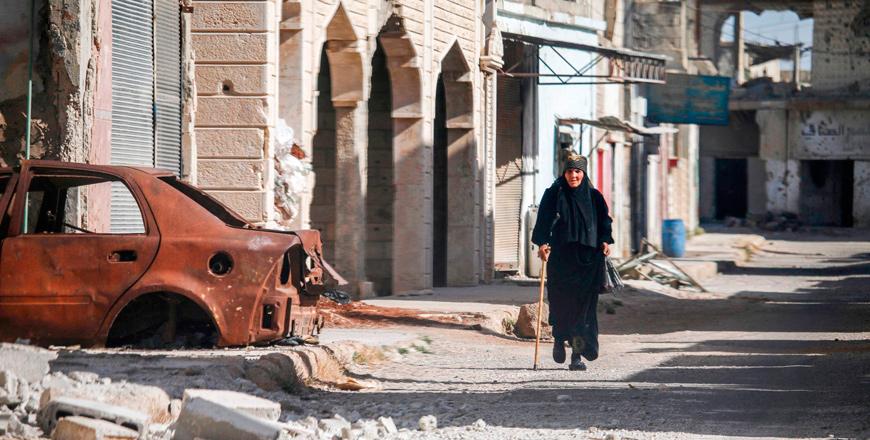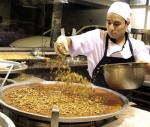You are here
Foreign minister to meet UN chief on Syria
By JT , Reuters - Jun 29,2018 - Last updated at Jun 29,2018

People gather with their belongings in Deraa countryside, Syria, in this handout released on Thursday (Reuters photo)
AMMAN/BEIRUT — Foreign Minister Ayman Safadi on Thursday said that he was due to meet UN Secretary General António Guterres to discuss developments in southern Syria as regime forces made new advances just across the border with the Kingdom.
“Will meet #UNSG on #Syria. Will address urgency of Int’l effort to achieve immediate ceasefire in south, provide protection to civilians inside their country and ensure needed assistance to them. Jordan remains engaged with all parties to achieve above as top priority,” Safadi wrote in a Tweet, without revealing the date of the meeting.
He made the remarks amid a firm Jordanian stance rejecting to open borders to a new wave of refugees fleeing the raging battles in areas that were supposed to be part of the de-escalation zone.
Meanwhile, Reuters reported that the Syrian army fought rebels in an important town in southwest Syria on Thursday, quoting a media unit run by its ally Hizbollah and a war monitor, as intensifying air strikes killed dozens of people in the area.
Syrian President Bashar Assad has sworn to take back every centimetre of Syria, and recapturing the southwest, one of the first hotbeds of the uprising against him, would leave rebels with only one remaining stronghold, in the northwest.
The area is in the “de-escalation zone” agreed last year by Jordan, the United States and Assad’s ally Russia to curb fighting. But despite American warnings that it would respond to an attack, it has not done so and Syrian opposition figures on Wednesday decried Washington’s “silence”.
Vassily Nebenzia, Russia’s ambassador to the United Nations, indicated that Russia would no longer uphold the de-escalation zone, saying it was among the last strongholds of Al Qaeda’s Syrian branch and Daesh, and the Syrian army has a “legitimate right” to fight “terrorists”.
“Every de-escalation zone that we established was not established for good,” Nebenzia told a news conference at the United Nations.
“I hope that all of the de-escalation zones will go into history and will have Syria territorially united under the control of the legitimate government. The de-escalation zone for those who are ready to uphold de-escalation still exists. But for those who resist any de-escalation, it doesn’t.”
Assad’s offensive in the southwest has been backed by air strikes and shelling that have killed 96 civilians since June 19, the Syrian Observatory for Human Rights war monitor said, including 49 on Wednesday and Thursday. Some 67 pro-government forces and 54 rebels have also been killed.
Insurgent territory in the southwest is strung along the borders with Jordan and the Israeli-occupied Golan Heights, narrowing to only a few kilometres wide at the city of Daraa.
The fighting so far had mostly focused on areas northeast of Daraa, where the army and allied militia recaptured a string of villages, but was extended to the city’s outskirts on Tuesday.
The Hizbollah media unit said the army had captured the town of Al Harak, northeast of Deraa. The observatory said it had advanced into the town’s centre but fighting continued.
A rebel official said the army and allied militia were also seeking to cut insurgent ground in the southwest in two by storming an air base close to the Jordanian border.
“The goal for them is to split the western Daraa countryside from the city and the eastern Daraa countryside. Praise God, so far the fighters are standing strong and the regime was not able to advance,” said Abu Shaima, a rebel spokesman.
The Britain-based monitoring group and two rebel sources said aircraft had bombed Busra Al Sham, Nawa, Rakham and other towns in the province.
‘Silence’
Warfare in southwestern Syria is sensitive to neighbouring Jordan and Israel, though government bombardments so far have not focused on territory nearest to the Golan Heights.
In Riyadh, the chief Syrian opposition negotiator Nasr Al Hariri condemned “US silence” over the offensive in the de-escalation zone, comparing it to Washington’s prompt use of force against attacks on forces it is allied to elsewhere.
Only a “malicious deal” could explain the lack of a US response to the assault, Hariri said.
Israel wants Iranian forces and Tehran-backed militia kept far from its border.
A US State Department official said on Wednesday Russia had agreed to work with Damascus to remove such forces to a defined distance from the Israeli and Jordanian borders, and from opposition-held territory in the southwest. “However, we have not yet seen this take place,” the official said.
There was no immediate comment on civilian deaths from the air strikes from Damascus or Moscow, which have said they only target armed militants in the seven-year conflict.
“We can’t even catch up to count the air strikes,” said Abdullah Mahameed, a rebel official in Daraa. “The house is shaking around us.”
Abu Jihad, a local opposition official near the border, said the violence since Wednesday had forced at least 11,000 people to flee their homes and towns. If the escalation continues, he said, people would head closer to the frontiers with Jordan and the Golan.
A Jordanian official who requested anonymity told Reuters the Jordanian army had stepped up its state of readiness at the border. The country already hosts more than 650,000 registered Syrian refugees and said it would not open the border for more.
The United Nations has said the southwestern assault has uprooted at least 50,000 civilians.
Related Articles
BEIRUT/UNITED NATIONS — Syrian regime forces on Saturday made their first gains on the ground against rebel fighters in the southern provinc
BEIRUT — The Syrian army said on Monday it would suspend combat operations in southern Syria until Thursday to help a new round of peace tal
AMMAN/BEIRUT — A major insurgent-held town in southwestern Syria has accepted the return of President Bashar Assad’s rule, pro-government me












